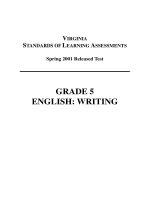Department reading english 3 pot
Bạn đang xem bản rút gọn của tài liệu. Xem và tải ngay bản đầy đủ của tài liệu tại đây (63.74 KB, 6 trang )
“polynucleated population groups,” “conurbations,” “metropolitan clusters,”
“megalopolises,” and so on.
39. What does the passage mainly discuss?
(A) How cities in the United States began and developed
(B) Solutions to overcrowding in cities
(C) The changing definition of an urban area
(D) How the United States Census Bureau conducts a census
40. According to the passage, the population of the United States was
first classified as rural or urban in
(A) 1870
(B) 1900
(C) 1950
(D) 1970
41. The word “distinguished”in line 3 is closest in meaning to
(A) differentiated (B) removed
(C) honored (D) protected
42. Prior to 1900, how many inhabitants would a town have to have before being
defined as urban?
(A) 2,500
(B) 8,000
(C) 15,000
(D) 50,000
43. According to the passage, why did the Census Bureau revise the definition
of urban in 1950?
(A) City borders had become less distinct.
(B) Cities had undergone radical social change.
(C) Elected officials could not agree on an acceptable definition.
(D) New businesses had relocated to larger cities.
44. The word “those”in line 9 refers to
(A) boundaries
(B) persons
(C) units
(D) areas
45. The word “constituting” in line 16 is closest in meaning to
(A) located near
(B) determined by
(C) calling for
(D) making up
46. The word “which ” in line 18 refers to a smaller
(A) population (B) city
(C) character (D) figure
47. Which of the following is NOT true of an SMSA?
(A) It has a population of at least 50,000
(B) It can include a city's outlying regions.
(C) It can include unincorporated regions.
(D) It consists of at least two cities.
48. By 1970, what proportion of the population in the United States did NOT live in
an SMSA?
(A) 3/4 (B) 2/3 (C) 1/2 (D) 1/3
49. The Census Bureau first used the term “SMSA” in
(A) 1900 (B) 1950 (C) 1969 (D) 1970
50. Where in the passage does the author mention names used by social scientists for
an urban area?
(A) Lines 4-5 (B) Line 7-8 (C) Line 21-23(D) Line 27-29
Test 2
Question 1 - 8
It is commonly believed in the United States that school is where people go to get an
education. Nevertheless, it has been said that today children interrupt their education
to go to school. The distinction between schooling and education implied by this remark
Line is important.
(5) Education is much more open-ended and all-inclusive than schooling. Education
knows no bounds. It can take place anywhere, whether in the shower or on the job,
whether in a kitchen or on a tractor. It includes both the formal learning that takes place
in schools and the whole universe of informal learning. The agents of education can
range from a revered grandparent to the people debating politics on the radio, from a
(10) child to a distinguished scientist. Whereas schooling has a certain predictability,
education quite often produces surprises. A chance conversation with a stranger may
lead a person to discover how little is known of other religions. People are engaged in
education from infancy on. Education, then, is a very broad, inclusive term. It is a
lifelong process, a process that starts long before the start of school, and one that
(15) should be an integral part of one's entire life.
Schooling, on the other hand, is a specific, formalized process, whose general
pattern varies little from one setting to the next. Throughout a country, children arrive
at school at approximately the same time, take assigned seats, are taught by an adult,
use similar textbooks, do homework, take exams, and so on. The slices of reality that
(20) are to be learned, whether they are the alphabet or an understanding of the workings of
government, have usually been limited by the boundaries of the subject
being taught.
For example, high school students know that they are not likely to find out in their
classes the truth about political problems in their communities or what the newest
filmmakers are experimenting with. There are definite conditions surrounding the
(25) formalized process of schooling.
1. What does the author probably mean by using the expression “children interrupt
their education to go to school” (lines 2-3) ?
(A) Going to several different schools is educationally beneficial.
(B) School vacations interrupt the continuity of the school year.
(C) Summer school makes the school year too long.
(D) All of life is an education.
2. The word “bounds”in line 6 is closest in meaning to
(A) rules
(B) experience
(C) limits
(D) exceptions
3. The word “chance” in line 11 is closest in meaning to
(A) unplanned
(B) unusual
(C) lengthy
(D) lively
4. The word “an integral” in line 15 is closest in meaning to
(A) an equitable
(B) a profitable
(C) a pleasant
(D) an essential
5. The word “they” in line 20 refers to
(A) slices of reality
(B) similar textbooks
(C) boundaries
(D) seats
6. The phrase “For example,” line 22, introduces a sentence that gives
examples of
(A) similar textbooks
(B) the results of schooling
(C) the workings of a government
(D) the boundaries of classroom subjects
7. The passage supports which of the followng conclusions?
(A) Without formal education, people would remain ignorant.
(B) Education systems need to be radically reformed.
(C) Going to school is only part of how people become educated.
(D) Education involves many years of professional training.
8. The passage is organized by
(A) listing and discussing several educational problems
(B) contrasting the meanings of two related words
(C) narrating a story about excellent teachers
(D) giving examples of different kinds of schools
Question 9-17
The hard, rigid plates that form the outermost portion of the Earth are about 100
kilometers thick. These plates include both the Earth's crust and the upper mantle.
The rocks of the crust are composed mostly of minerals with light elements, like
Line aluminum and sodium, while the mantle contains some heavier elements, like iron and
(5) magnesium. Together, the crust and upper mantle that form the surface plates are called
the lithosphere. This rigid layer floats on the denser material of the lower mantle the
way a wooden raft floats on a pond. The plates are supported by a weak, plastic layer
of the lower mantle called the asthenosphere. Also like a raft on a pond, the
lithospheric plates are carried along by slow currents in this more fluid layer beneath
(10) them.
With an understanding of plate tectonics, geologists have put together a new history
for the Earth's surface. About 200 million years ago, the plates at the Earth's surface
formed a “supercontinent” called Pangaea. When this supercontinent started to tear
apart because of plate movement, Pangaea first broke into two large continental masses
(15) with a newly formed sea that grew between the land areas as the depression filled with
water. The southern one ― which included the modern continents of South America,
Africa, Australia, and Antarctica ― is called Gondwanaland. The northern one ― with
North America, Europe, and Asia ― is called Laurasia. North America tore away from
Europe about 180 million years ago, forming the northern Atlantic Ocean.
(20) Some of the lithospheric plates carry ocean floor and others carry land masses or a
combination of the two types. The movement of the lithospheric plates is
responsible
for earthquakes, volcanoes, and the Earth's largest mountain ranges. Current
understanding of the interaction between different plates explains why these occur
where they do. For example, the edge of the Pacific Ocean has been called the “Ring
(25) of Fire” because so many volcanic eruptions and earthquakes happen there. Before the
1960's, geologists could not explain why active volcanoes and strong earthquakes
were concentrated in that region. The theory of plate tectonics gave them an answer.
9. With which of the following topics is the passage mainly concerned?
(A) The contributions of the theory of plate tectonics to geological knowledge
(B) The mineral composition of the Earth's crust
(C) The location of the Earth's major plates
(D) The methods used by scientists to measure plate movement
10. According to the passage, the lithospheric plates are given support by the
(A) upper mantle
(B) ocean floor
(C) crust
(D) asthenosphere
11. The author compares the relationship between the lithosphere and the
asthenosphere to which of the following?
(A) Lava flowing from a volcano
(B) A boat floating on the water
(C) A fish swimming in a pond
(D) The erosion of rocks by running water
12. The word“one”in line 16 refers to
(A) movements
(B) masses
(C) sea
(D) depression
13. According to the passage, the northern Atlantic Ocean was formed when
(A) Pangaea was created
(B) plate movement ceased
(C) Gondwanaland collided with Pangaea
(D) parts of Laurasia separated from each other
14. The word “carry” in line 20 could best be replaced by
(A) damage
(B) squeeze
(C) connect
(D) support
15. In line 27, the word “concentrated” is closest in meaning to which of the following?
(A) Allowed
(B) Clustered
(C) Exploded
(D) Strengthened
16. Which of the following can be inferred about the theory of plate tectonics?
(A) It is no longer of great interest to geologists.
(B) It was first proposed in the 1960's.
(C) It fails to explain why earthquakes occur.
(D) It refutes the theory of the existence of a supercontinent.
17. The paragraph following the passage most probably discusses
(A) why certain geological events happen where they do
(B) how geological occurrences have changed over the years
(C) the most unusual geological developments in the Earth's history
(D) the latest innovations in geological measurement
Question18-27
In the United States in the early 1800's, individual state governments had more
effect on the economy than did the federal government. States chartered
manufacturing, banking, mining, and transportation firms and participated in the
Line construction of various internal improvements such as canals, turnpikes, and railroads.
(5) The states encouraged internal improvements in two distinct ways ; first, by actually
establishing state companies to build such improvement ; second, by
providing part of
the capital for mixed public-private companies setting out to make a profit.
In the early nineteenth century, state governments also engaged in a surprisingly
large amount of direct regulatory activity, including extensive licensing and inspection
(10) programs. Licensing targets reflected both similarities in and differences between the









